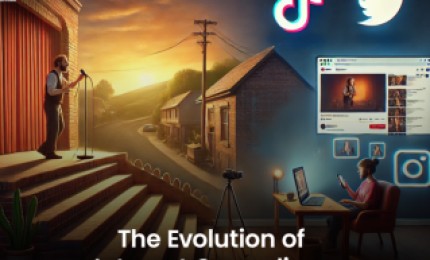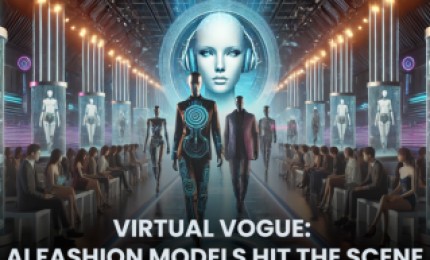Technology has profoundly transformed theatre from ancient times to the present, enhancing every aspect of production and performance. Historically, theatre relied heavily on the natural acoustics of open-air amphitheatres and simple mechanical devices, such as the crane used in Greek theatre to simulate flight, a technique known as "deus ex machina."
The origins of theatre trace back to 6th century B.C. in Ancient Greece, a pivotal era for theatrical development. The art form was deeply integrated into Greek culture with performances held in the Theater of Dionysus in Athens and spreading throughout Greece. Early performances were simplistic, often involving a single actor and a chorus, which narrated or commented on the action. These actors had to project their voices across vast spaces, relying solely on the natural acoustics provided by the architectural design of theatres which were strategically built to capture and enhance sound.
Technological advancements over the centuries have dramatically altered theatrical production. Today's theatres incorporate sophisticated technologies including advanced lighting systems, sound amplification, and 3D printing for props and set designs. These innovations not only enhance the visual and auditory experience but also expand creative possibilities for set and costume designers.
Lighting technology, for example, has evolved from the natural lighting of Greek amphitheatres to the complex, computer-controlled lighting systems used today that can change the mood and setting of a play with the push of a button. Similarly, sound systems have developed from the basic need to project actors' voices to sophisticated, multi-channel surround sound systems that deliver clear and precise audio throughout modern theatres.
Moreover, the integration of digital technologies like projection mapping and augmented reality has opened new avenues for creating immersive environments on stage, blurring the lines between reality and theatrical illusion. These tools allow for dynamic backgrounds and special effects that were unimaginable in earlier eras.
The evolution of theatre technology not only improves audience engagement but also provides theatre practitioners with an expanded toolkit for storytelling, enabling more complex and nuanced narratives. As theatre continues to evolve, the fusion of traditional elements with cutting-edge technology promises to keep this ancient art form vibrant and relevant in the digital age.
The Evolution of Visual Technology in Theater
Visual storytelling in theatre has a rich history, evolving from ancient Greek practices to modern technological marvels. Historically, theatrical productions have aimed to captivate audiences with visually stunning presentations. Ancient Greeks used mechanical devices like cranes to hoist actors into the air, simulating flight, which added a dramatic element to their plays.
Today, technological advancements have significantly enhanced the visual aspects of theatre. Automation and 3D printing have revolutionised set design, allowing for quicker assembly and more intricate details, which enrich the audience's immersion into the narrative. These technologies enable designers to create complex and dynamic environments that were previously impossible or impractical.
Moreover, the integration of video and multimedia into live performances has opened new avenues for creativity. Video backdrops can simulate environments and weather conditions such as fog, rain, and shifting clouds, extending the set beyond physical limitations. This use of multimedia is particularly effective in productions with limited cast members, where video clips can provide contextual background or visual storytelling elements that complement the on-stage performance.
Lighting technology has also undergone significant transformations. In the past, open-roof designs and natural light were necessary for illumination, supplemented at times by hazardous methods like firelight. The 19th century introduced limelight, which could be manipulated with lenses and reflectors to focus and direct light more effectively. However, it was the advent of electrical lighting that truly changed the theatre landscape, providing safer and more versatile lighting options.
Contemporary theatre uses sophisticated digital light boards capable of controlling extensive arrays of lights. LED technology and advanced electrical systems allow for precise adjustments in brightness, colour, and patterns, enabling light designers to evoke moods and atmospheres that enhance the storytelling experience. This precise control transforms how stories are told on stage, making lighting not just a necessity, but an integral part of the artistic expression in modern theatre.
These advancements in technology not only improve the safety and functionality of theatrical productions but also expand the creative possibilities for directors and designers, continuing the tradition of visual spectacle in theatre.
Technological advancements have dramatically transformed the auditory landscape of theatrical productions, enhancing both the audience's experience and the performers' capabilities.
Sound Effects and Music: Modern technology has streamlined the process of incorporating sound effects and music into live performances. Production teams no longer need to create these elements from scratch; instead, they can access vast online libraries to download high-quality sound effects and musical tracks. Sound design software has further revolutionised this aspect by enabling directors to layer multiple sounds seamlessly. This technology allows for the addition of realistic background noises, ambient sounds, and special effects that enhance the narrative and set the mood without overwhelming the live action on stage.
Microphone Technology: The development of microphone technology has been a game-changer for theatrical productions. Historically, actors needed to project their voices to reach the back rows of a theatre, which could strain their voices and limit their performance. Today, microphones—ranging from handheld devices to sophisticated flesh-colored headsets and tiny mics hidden within actors' hair or costumes—ensure that their voices are heard clearly without requiring them to shout. These microphones are connected to advanced sound systems with speakers strategically positioned around the theatre to provide a clear and balanced sound.
Personal Audio Devices: On a more personal level, technology like earpieces and on-stage monitors have been employed to assist performers during live shows. These devices can feed lines to actors, helping them with cues and dialogue. An example of this technology in use was Bruce Willis's performance in the Broadway adaptation of "Misery," where he used an earpiece to receive his lines. While such aids are available, their use varies, with some performers preferring to rely on traditional methods of memorization and cue taking.
These technological enhancements in sound have not only improved the quality of productions but have also made theatre more accessible and enjoyable for audiences. They reduce the physical strain on actors and allow for more dynamic and varied performances, ultimately enriching the theatrical experience for everyone involved.
The use of scent in theatre, often overlooked, is a powerful sensory tool that can deeply immerse audiences into a performance's environment. Historically, the incorporation of smells into theatre was incidental, limited to the natural diffusion of odours from actions on stage, such as cooking or smoking. This method depended heavily on the physical proximity of the audience to the source of the scent, often leading to inconsistent and unpredictable experiences across the theatre.
In contemporary theatre, the strategic use of scents—termed "aroma-turgy"—has evolved with technological advancements. This technique involves the intentional integration of olfactory elements into theatrical design to enhance storytelling and evoke specific emotional responses. Traditional methods of scent dissemination were unreliable; scents like food or cigarette smoke would dissipate naturally, often not reaching all audience members or merging with other ambient odours of the theatre space.
The advent of dry vapour scenting systems has revolutionised this aspect of theatrical production. These advanced systems utilise high-tech diffusers that release scents in a controlled manner, ensuring that they permeate the entire theatre at precise moments during the performance. Unlike earlier methods, these modern systems can activate scents on cue, maintaining the director's artistic intent and ensuring that every audience member experiences the scent simultaneously, regardless of their seating location.
This technology not only ensures consistency in how the audience experiences the play but also expands the creative palette for set designers and directors. They can now script scents into the narrative just as they would light or sound cues, using them to enhance scenes or shift audience emotions subtly. This method of sensory engagement allows productions to create a more immersive and memorable experience, drawing the audience deeper into the world of the play.
Technology has significantly transformed the theatrical experience, bringing innovations that enhance both the performance and audience engagement. One of the most transformative aspects has been the evolution of lighting technology. Historically, theatres relied on natural light, necessitating open-air venues and daytime performances to ensure visibility. This practice restricted the creative capabilities of lighting in theatre.
Today, electric lighting technology liberates theatrical productions from these constraints, allowing performances to occur at any time of day or night. The advent of LED and digital lighting systems has revolutionised how lighting is used on stage. These advancements provide designers with an extensive palette of colours and intensities to work with, enabling precise control over the mood and atmosphere of a scene. Digital lighting systems, operated via computerised controls, can dynamically adjust lighting effects in real-time, enhancing the visual storytelling with seamless transitions and dramatic effects that were not possible with traditional lighting methods.
This shift not only expands the creative possibilities for lighting designers but also elevates the overall production quality, making the theatrical experience more immersive and visually captivating for the audience.
The evolution of theatre lighting has seen a dramatic shift from traditional methods to advanced, digital systems. Historically, setting up stage lighting was a cumbersome process that involved hanging multiple lights, each fitted with coloured gels to achieve the desired hue. This manual setup was not only time-consuming but also limited in flexibility.
The introduction of Light Emitting Diodes (LEDs) around 2007 marked the beginning of a new era in stage lighting, although their initial adoption was slow. Early LEDs were limited to basic red, green, and blue outputs, which posed challenges in achieving natural skin tones and were therefore primarily used for background lighting. However, the development of LEDs capable of emitting a spectrum of seven colours significantly expanded their usability. This technological advancement allowed lighting designers to experiment with a wider range of colours, improving the quality of lighting on performers and thus facilitating LEDs' acceptance in mainstream theatre productions.
LEDs have revolutionised stage lighting with features like built-in dimmers and the ability to change colours instantaneously without the need for physical filters or mechanical adjustments. Available in various formats such as strip lights, moving heads, and PAR cans, LEDs offer longevity and energy efficiency, making them a favoured choice in modern theatres.
Digital lighting takes this innovation further by integrating LED lights into a digital network that allows for precise control over every aspect of lighting. Through a centralised control station, operators can manipulate light patterns, intensity, and colours across the stage and even extend these capabilities to the lobby, enhancing the overall ambiance of the theatre environment. This system not only simplifies the management of lighting but also opens up creative possibilities that were unimaginable with traditional lighting technologies.
Sound technology in theatre has also seen significant advancements. Modern speaker systems and microphones, which became prominent in the 20th century, have greatly enhanced the auditory experience of theatre productions. These technologies ensure clear and balanced sound distribution, making performances more accessible and enjoyable for audiences.
In summary, the transition from manual lighting setups to sophisticated digital systems represents a leap forward in theater technology, offering unprecedented control and creative potential to lighting designers and directors, while advances in sound technology continue to enrich the auditory experience for theater-goers.
By the 1960s, the use of microphones had become commonplace in musical theater, enhancing vocal projection over orchestral accompaniments. Initially, microphones were strategically placed along the stage's front edge or suspended from above, designed to capture sound from both the downstage and upstage areas. This setup, however, limited performers' movement as they needed to remain near the microphones to be heard clearly.
The 1980s marked a significant advancement with the introduction of miniaturised wireless microphones, revolutionising performance dynamics by freeing actors from the confines of stationary mics. These wireless systems employed FM radio transmitters, discreetly attached to the actor, which relayed sound to a central mixing desk. This technology not only improved sound quality but also allowed for greater flexibility and expressiveness in performances.
Today's wireless microphones continue to refine audio quality and discreetness, often being integrated into headsets with flesh-coloured mouthpieces or hidden within an actor's hair. This evolution in microphone technology has profoundly impacted theatrical productions, ensuring crystal clear audio while supporting the full range of performers' mobility on stage.
The evolution of audio technology, particularly amplifiers, speaker enclosures, and loudspeakers, has profoundly transformed theatrical productions. With the advent of microphones, actors could effortlessly project their voices across large spaces, supported by speakers that also played pivotal roles in delivering music and sound effects, enriching the overall stage action.
Speaker systems centralised the control of music and effects, allowing for consistent sound levels throughout the theatre. This technological advancement enabled productions to create more realistic and immersive auditory environments, greatly enhancing the audience's experience.
Modern speaker systems empower sound operators to meticulously direct and fine-tune all auditory elements of a production from a single location. Using a mixing desk, operators can adjust microphone levels for each performer, cue sound effects precisely when needed, and seamlessly integrate music into the performance. This centralised control is crucial in achieving a polished and immersive sound landscape that is vital for today’s dynamic theatrical experiences.
Modern technology has significantly enhanced the visual aspects of theatrical productions. Innovations like 3D printing, automation, and advanced rigging systems have revolutionised stage design, enabling creators to craft more immersive and visually captivating experiences. These technological advancements allow for quicker set changes, more intricate scenery, and dynamic effects that draw audiences deeper into the narrative, enriching the overall theatrical experience.
3D printing has transformed set design by streamlining the creation of props and set pieces. Designers can now craft their visions using 3D software and easily translate these designs into physical prototypes. This technology not only saves considerable time and labour but also empowers designers to experiment with diverse designs and facilitate rapid set changes, enhancing the efficiency and creativity of theatrical productions.
Automation and modern rigging systems have revolutionised theatrical productions by enabling precise and effortless manipulation of set pieces and scenery. With the integration of cable systems, motors, electronic control boxes, and sophisticated control software, theatres can execute complex scene changes smoothly and reliably. This technology not only simplifies the work of stagehands—who previously relied on manual labour to shift heavy sets—but also enriches the creative possibilities for directors, allowing them to design intricate stage setups and transitions.
Automation is now a staple in theatres at every level, from Broadway productions to community and high school performances. The convenience of executing precise scenic movements at the push of a button has solidified its role in contemporary theatre.
Meanwhile, advancements in rigging technology have significantly enhanced safety and functionality. While traditional counterweight systems remain prevalent, the introduction of automated rigging powered by electrical winches represents a major leap forward. These motorised systems can be programmed to perform specific tasks such as smoothly flying actors onto the stage or transitioning scenery, reducing the need for manual operation and allowing stage crews to focus on other aspects of the production. This shift not only improves operational efficiency but also expands the creative scope for dynamic and visually captivating stage effects.
The integration of advanced technologies like 3D printing, automation, and sophisticated rigging systems has profoundly transformed the theatre, enhancing both the spectacle and functionality of modern productions. These innovations allow for more intricate and dynamic set designs, streamlined scene changes, and safer, more engaging performances. As technology continues to evolve, it opens up new creative possibilities, enabling theatres to deliver experiences that captivate and immerse audiences like never before.Are you ready to take your theatre production to the next level? Discover how All Talent can empower your creative vision with cutting-edge technologies. From enhancing visual effects to optimising sound design, All Talent provides the tools and expertise you need to revolutionise your performances. Join us today to harness the transformative power of technology and create unforgettable theatrical experiences. Visit All Talent to learn more and start your journey towards a more innovative and impactful production!

When Kunal Kamra's Humor Got Him Into Trouble: A Deep Dive into the Controversies of India's Most Fearless ComedianKunal Kamra Controversy: Laughter, Lawsuits, and the Limits of Free SpeechStand-up...
Read Blog
The Oscar race is always full of drama, but this year? It’s absolute chaos. From shocking controversies to unexpected winners, the battle for Best Picture at the 2024 Academy Awards has taken...
Read Blog
In the ever-changing landscape of entertainment, few transformations have been as dramatic and swift as the rise of internet comedians. What began as a platform for amateur funny videos has evolved...
Read Blog
Introduction: In the competitive world of entertainment and talent, having the right representation can make all the difference in launching and sustaining a successful career. Whether you're...
Read Blog.jpg)
While the world of modelling often dazzles with glitz and glam, it's also critical we discuss its darker shades, pulling the curtain back on some challenging realities. Today, let's embark on...
Read Blog
AI Fashion Models: Boon...
Read Blog